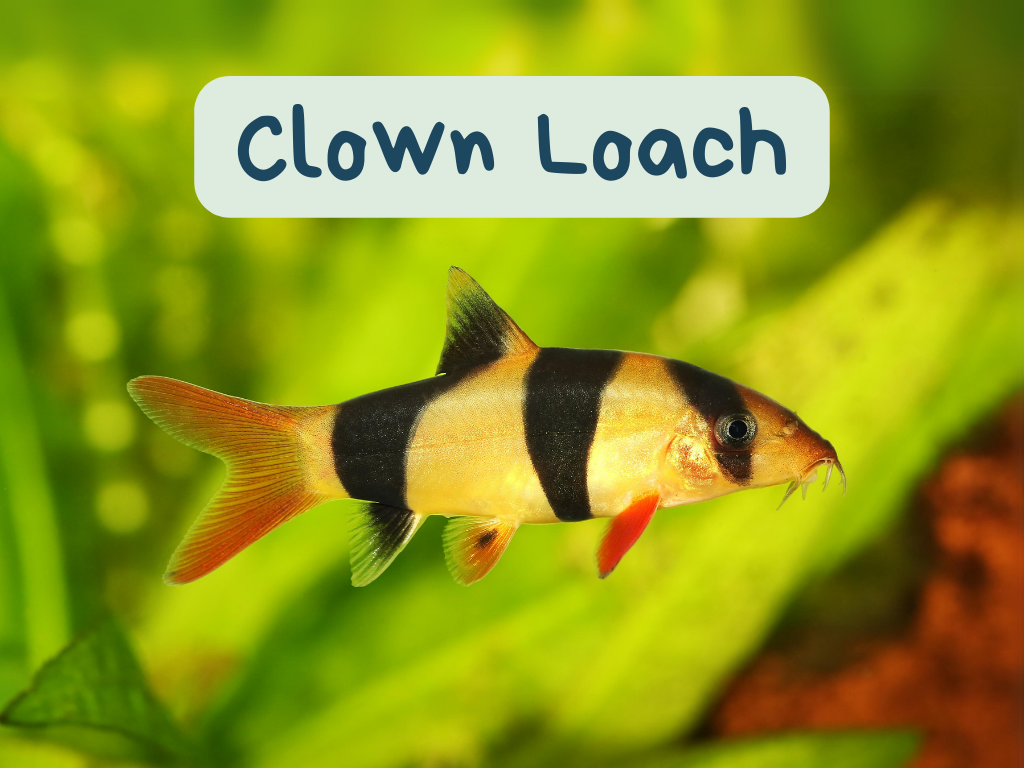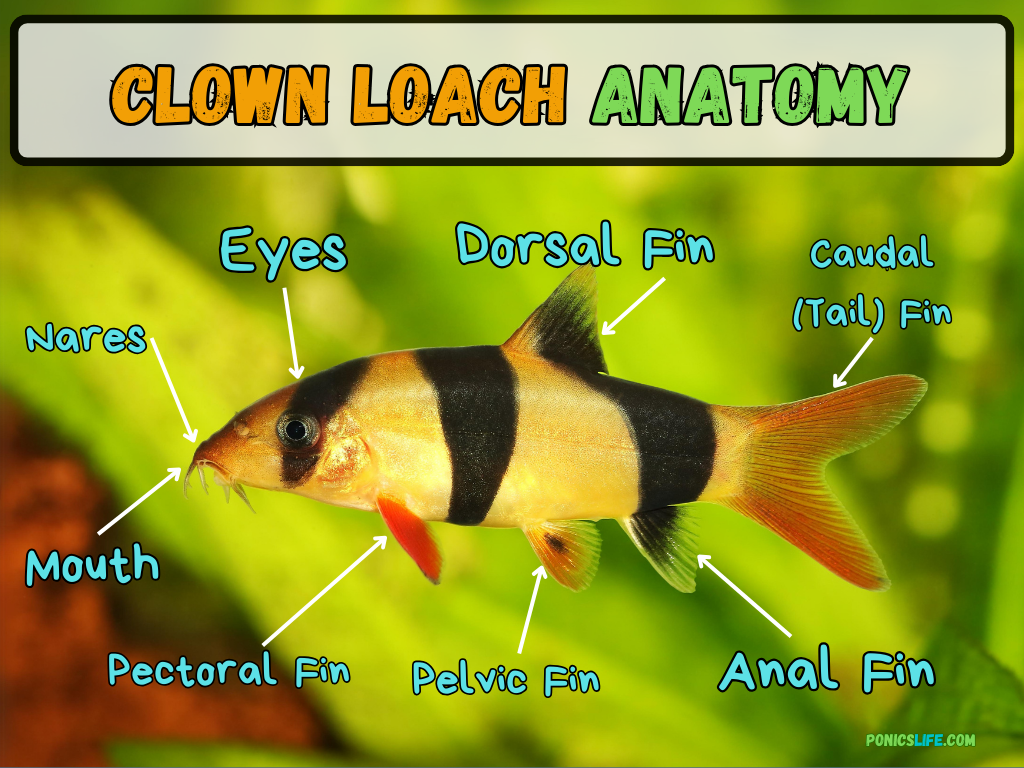Description: The Clown Loach, with its vivid orange hue and distinctive trio of black bands, is an eye-catching species. Its elongated body is accentuated by a pronounced arch on its back and a streamlined underside. Highlighting its facial features are the uniquely colored barbels, ranging from whitish-orange to a deeper reddish tone, that drape near its mouth.
Temperament: Known for their peaceful disposition, Clown Loaches become the life of the tank with their engaging and sociable behavior. They thrive in the company of their own kind, forming intricate social networks that contribute to their overall wellbeing. Their playful antics and interaction with tank mates make them a fascinating spectacle in any aquarium setting.

Identification
Clown Loach
Common Name: Clown Loach
Other Names: Tiger Botia
Scientific Name: Chromobotia macracanthus
Order: Cypriniformes
Family: Botiidae
Genus: Chromobotia
Species Facts
Clown Loach
Temperament: Generally Peaceful
Max Size: Around 12 inches (30.5 cm)
Fish Origin: Indonesia
Diet: Omnivore
Reproduction: Egg Depositor
Max Lifespan: Around 20 Years
Tank Care
Clown Loach
Environment: Freshwater
pH: 5.0 – 7.0
Hardness: 18 – 215 ppm
Temperature: 75°F to 86°F (24°C to 30°C)
Minimum Tank Size: 75 gallons
Recommended # in group: at least 5
Care and Habitat
Clown Loach Care: Creating a habitat that mirrors their natural environment is key to their care. This includes a tank setup with ample water flow and oxygenation, coupled with a substrate of fine sand to safeguard their sensitive barbels. Shaded retreats are essential, provided by wood and cave structures, alongside consistent bi-weekly water changes to ensure a clean habitat. Temperature should be kept between 75°F and 86°F (24°C to 30°C), with a soft, slightly acidic water condition. Proper tank management and stable water quality are paramount to accommodate their growth and activity needs.
Difficulty: Suitable for hobbyists with beginner to intermediate experience, Clown Loaches are adaptable yet require mindful attention to their dietary and environmental needs. They offer a rewarding experience to those committed to their care, showcasing their vibrant personality and complex behaviors.
Swim Level: As bottom-dwellers, Clown Loaches are often found exploring the aquarium floor, yet don’t be surprised to see them venturing into midwater. This behavior is especially prominent during feeding or when they engage in their playful movements throughout the tank.
Tankmates: When selecting companions, opt for peaceful, similarly sized community fish. It’s crucial to steer clear of aggressive species or those with delicate fins that could attract unwanted attention from these otherwise peaceful loaches. Potential tankmates include several other non-aggressive fish including larger gouramis, tetras, and rasboras.
Clown Loach Diet: An omnivorous diet that includes a mix of high-quality dried, live, and frozen foods, supplemented with vegetable matter, caters to the Clown Loach’s nutritional needs. In the wild, their diet consists of invertebrates and plant material, a preference that should be mirrored in captivity to maintain their health and vigor.
Male vs Female: Sexual differentiation in Clown Loaches is subtle, with males typically showcasing a slightly more pronounced body shape and distinct fin characteristics compared to the sleeker, more streamlined females. While difficult to identify in younger clown loaches, this distinction becomes more apparent in mature individuals.
Natural Habitat: Originating from the Indonesian islands of Sumatra and Borneo, Clown Loaches inhabit environments where soft, acidic water flows through vegetated areas offering plenty of shade. They are adaptable, residing in both clear streams and the murky waters of floodplains, showcasing their resilience and the varied nature of their preferred habitats.

IUCN Red List Status: The Clown Loach is categorized as Least Concern (LC) by the International Union for Conservation of Nature (IUCN), which means that it does not currently qualify as Critically Endangered, Endangered, Vulnerable, or Near Threatened.
Reproduction: Breeding Clown Loaches in an aquarium setting is a challenging yet intriguing endeavor, necessitating mature fish and finely tuned environmental conditions. Their natural breeding behavior involves migration to spawning grounds in response to seasonal changes, a complexity that underscores the difficulty of replicating their reproductive cycle in captivity. Success requires a deep understanding of their needs and meticulous care to mimic the natural triggers for spawning.

Aquaponic Considerations
Aquaponics is a sustainable farming method that combines aquaculture (raising fish) and hydroponics (growing plants in water) in a symbiotic environment. To learn more, explore our Aquaponics Information and Hobby Center.
| Can be used for Aquaponics | Yes |
| Indoor or Outdoor | Indoor Aquarium |
| Ornamental or Edible | Ornamental |
| Stocking Density | 5 fish per 75 gallons |
FAQs
Where did this information come from?
The primary resources used for this article include the IUCN Red List of Threatened Species, FishBase, and other aquarium databases.
How often should I feed my fish?
Aquarium fish generally require feeding once or twice a day. It’s important to provide only as much food as they can consume within a few minutes to prevent overfeeding and potential water quality issues. Adjust the feeding schedule and quantity based on the fish’s activity level and the water temperature, as their metabolism slows down in cooler conditions.
How do I choose compatible tankmates for my aquarium?
When selecting tankmates, consider the temperament, size, and dietary needs of the fish. Peaceful species that grow to similar sizes and have comparable dietary requirements usually make good companions. Avoid pairing aggressive or fin-nipping species with slow-moving or long-finned fish. Researching each species’ behavior and needs is key to creating a harmonious aquarium.
What is the ideal number of fish for my aquarium?
The “one inch of fish per gallon” rule is a common guideline, but it oversimplifies the complexity of maintaining a healthy aquarium. Factors such as the species’ adult size, behavior, and the tank’s filtration capacity are crucial. Start with a conservative number of fish and increase gradually, ensuring the aquarium’s biological filter can handle the waste load.
What should I do if my fish show signs of stress or illness?
First, check your water quality parameters (temperature, pH, etc.) and make sure they’re within the ideal range for your fish. Stress and illness often stem from poor water quality or incorrect temperatures. Isolate sick fish if possible, research their symptoms to identify the issue, and treat accordingly with medication or by adjusting the water conditions. You can read more about fish stress here.
How important is lighting in an aquarium?
Proper lighting is essential for simulating natural daylight cycles, which help regulate fish behavior and physiological functions. It’s also critical for the growth of live plants, which rely on light for photosynthesis. Use aquarium-specific lights and set them on a timer to provide your fish and plants with a consistent light-dark cycle.
Can plants and decorations affect my fish?
Yes, live plants can greatly benefit an aquarium by providing oxygen, hiding places, and natural boundaries that help reduce stress in fish. Decorations should be chosen with care to avoid sharp edges that could injure fish. Ensure all items are safe for aquarium use to avoid contaminating the water.






